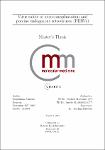Virus safety of xenotransplantation and porcine endogenous retroviruses (PERVs)
Anders, Maximilian
Introduction: The shortage of organs for patients is an issue that needs addressing. Xenotransplantation using pig cells or organs is the most favored option. However, pigs contain porcine endogenous retroviruses (PERV) in their genome which infect human cells. Like all retroviruses PERVs have immunosuppressive properties and may induce tumors. The mechanism of immunosuppression is unclear, but in the transmembrane envelope protein p15E a so-called immunosupppressive (isu) domain was identified. To prevent PERV transmission, a vaccine based on neutralizing antibodies may be useful. Previous results showed that immunization with TM proteins with mutations in the isu domain induced higher titers of antibodies compared with the wild-type. Methods and results: To develop an improved vaccine against PERVs, mutations were introduced in the isu domain after sub-cloning of env of PERV-A(42). Since the molecular clone PERV-A(42) was found not replication-competent, the mutants could not be tested in vivo . Although mutations in the env gene could not be detected, Western blot and immunofluorescence analysis, as well es transmission electron microscopy demonstrated the release of so-called Gag particles. To circumvent these shortcomings a PERV-A/B hybrid was generated, introducing the env of PERV-A(42) into a non-functional PERVB( 33). In addition, vectors were generated expressing the wild-type and mutated Env proteins. To analyze the influence of PERV on human immune cells, a virus preparation of recombinant PERV-A/C was added to human PBMCs and the release of IL-10 was analyzed. A low production of IL-10 was observed. Although the virus preparation was minimally contaminated with endotoxin, also able to induce IL-10, an inhibitor of the receptor of endotoxin, TAK-242, did not inhibit the whole activity. Discussion: The produced recombinant wild-type and mutant p15E will allow testing for the activity to induce IL-10 and other cytokines and will be used for immunization. Since PERV-A(42) was not replication-competent, other strategies have to be followed to obtain viruses with and without mutations.
Files in this item
No license information

